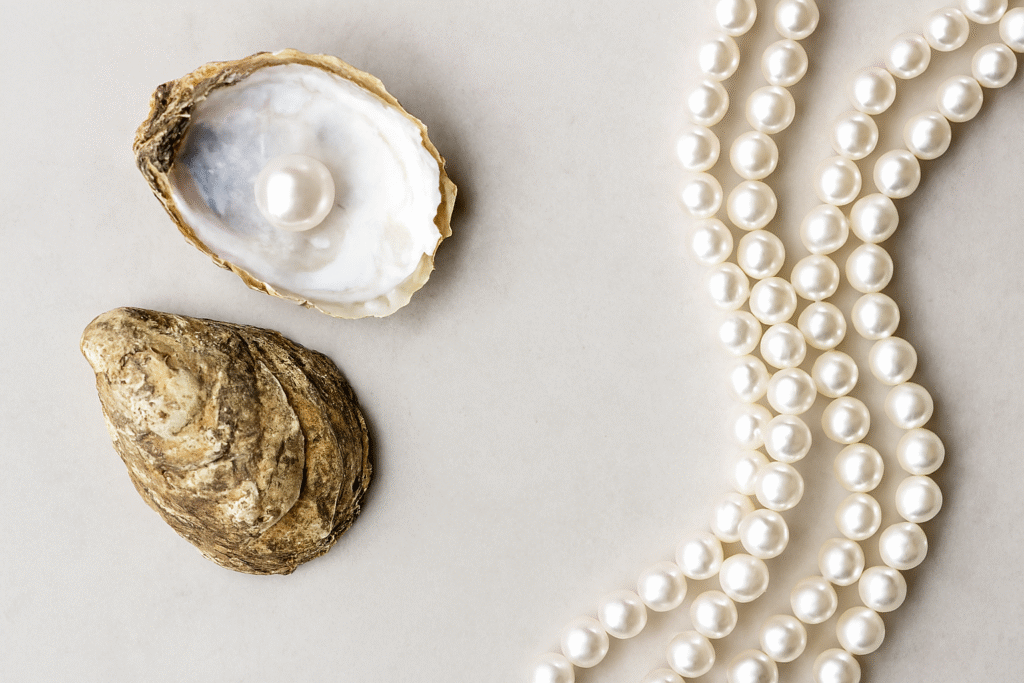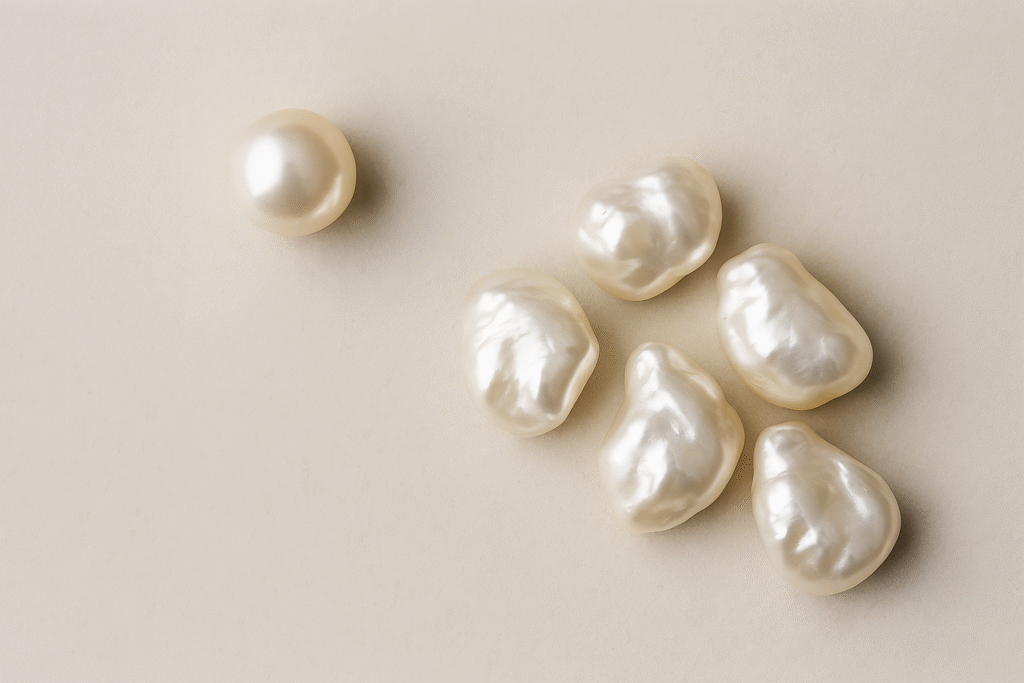Buying pearls online can be tricky. One of the most common mistakes buyers make is trusting a single, blurry product photo. Pearls are unique gems, and no two strands look the same. If you shop without enough details, you risk overpaying or receiving poor-quality pearls.
Why a Single Photo is Risky
- A blurry image hides blemishes and luster differences.
- You can’t judge surface quality or nacre thickness.
- Lighting tricks may misrepresent size and color.
- Without comparison shots, scale is misleading.
Research shows that over 70% of jewelry returns in e-commerce are due to misrepresentation of product photos. The key is to demand multiple angles and high-resolution close-ups.
How to Buy Pearls Online Safely
- Look for sellers offering at least 5–7 clear photos from different angles.
- Ask for a short video clip showing luster under natural light.
- Read a detailed product description covering size, origin, nacre thickness, and surface grade.
- Check for a transparent return policy with at least 7–14 days.
- Buy from reputable sellers with customer reviews and recognized memberships (e.g., Jewelers of America, GIA alumni).
Expert Tip
“The key is to never buy pearls online unless you can see how they reflect light. A high-luster pearl will show sharp reflections, even in photos.”
Q&A: Buying Pearls Online
Q: Can I trust stock photos of pearls?
A: No. Stock photos are generic and don’t represent the exact strand you’ll receive.
Q: What should a return policy include?
A: Clear instructions, free or low-cost returns, and no hidden restocking fees.
Q: How do I verify authenticity?
A: Look for certification, seller reputation, and ask for origin details (Akoya, Tahitian, South Sea, or Freshwater).
Case Example
A buyer in New York ordered a $500 strand based on one photo. The pearls arrived dull, off-round, and mismatched. After returning them, the buyer purchased from a GIA-trained seller who provided videos and detailed grading. The difference was clear: the second strand had 90% higher luster and matched size within 0.5 mm.
Learn more about grading pearls by luster and surface before making a purchase.
Compare pearls with gold jewelry buying mistakes to avoid.
Guide on hallmarking standards in jewelry for additional insights.
If you’re shopping in New York, read about certified diamond buying tips in NYC.
This comprehensive global cuisine FAQ covers everything about Asian and Western food and drinks. Whether you’re exploring international cooking techniques or discovering new flavors, this global cuisine FAQ answers the most frequently asked questions about world food traditions, ingredients, and culinary practices from both Eastern and Western cultures.
Global Cuisine FAQ: Asian & Western Food & Drinks
Food reveals cultural contrasts in clear and delicious ways. From cooking methods to dining customs, Asian and Western cuisines showcase unique traditions while also offering fascinating overlaps. Below, you’ll find answers to the most common questions about these culinary worlds.
Understanding Core Differences in Cuisine
1. What distinguishes Asian and Western culinary traditions?
Asian meals often rely on rice or noodles as a foundation. Flavors usually come from soy sauce, ginger, garlic, and a wide variety of spices. Meanwhile, Western gastronomy emphasizes bread, potatoes, and pasta. Dairy plays a key role, with butter, cream, and cheese giving richness to many dishes. Herbs such as rosemary and thyme highlight European cooking. These contrasts create distinct dining habits and flavor profiles.
2. Are Asian dishes always spicy?
No, not at all. While cuisines from Thailand and parts of India feature bold use of chilies, not every dish follows this pattern. Japanese sushi, Chinese dim sum, and Korean bulgogi are mild examples. In fact, Asian cuisines range from fiery to delicate, showcasing a rich palette of flavor.
Western Breakfast Staples and Comfort Foods
1. What constitutes typical Western morning meals?
Western breakfasts often include eggs, bacon, and toast. Pancakes, waffles, and cereal are also popular choices. These hearty starts are usually enjoyed with coffee, tea, or juice, providing both energy and comfort.
2. What represents popular Western comfort foods?
Comfort foods in the West speak to nostalgia and indulgence. Creamy macaroni and cheese, pizza, and hearty casseroles are favorites. Similarly, burgers and fried chicken have wide appeal. Because they are warm, filling, and familiar, these dishes strongly connect to emotion.
Cultural Dining Practices
1. Do all Asian cultures employ chopsticks?
No. Chopsticks dominate in East Asia—China, Japan, and Korea. However, Southeast Asia prefers spoons and forks, while India and parts of the Middle East often use flatbreads or hands. This diversity highlights how food customs closely reflect culture.
2. Why are some Asian foods fermented?
Fermentation preserves food while also enhancing nutrition and flavor. Korean kimchi, Japanese miso, and Indonesian tempeh show how tradition meets health benefits. These foods are valued not only for taste but also for their role in well-being.
Common Western Beverages
1. What beverages are common with Western meals?
Western dining often features water, soda, or fresh juice. Alcohol also has a strong cultural connection, with wine served at European dinners and beer central in North America. In the southern United States, sweet iced tea is a staple.
Dietary Flexibility and Options
1. Can one discover plant-based options easily?
Yes. Asian cuisines offer tofu stir-fries, lentil dals, and vegetable curries that are naturally vegetarian. Western food, similarly, embraces plant-based eating. Salads, vegetarian pastas, and vegan burgers have grown popular, making meat-free dining accessible worldwide.
Unique Asian Drinks to Explore
1. What are some unique Asian beverages?
Asia provides a wide variety of distinctive drinks. Bubble tea, from Taiwan, combines tea with chewy tapioca pearls. Japanese sake, made from rice, holds deep cultural meaning. Strong Vietnamese iced coffee, sweetened with condensed milk, adds a bold twist compared to Western brews.
Portion Sizes and Dining Habits
1. How do portion sizes compare?
Western meals often emphasize large servings, reflecting abundance. By contrast, Asian meals are usually smaller yet balanced, encouraging sharing and mindful eating. This creates different social experiences around the table.
The Art of Fusion Cuisine
1. Is it feasible to integrate Asian and Western flavors?
Absolutely. Fusion cuisine blends traditions in creative ways. For instance, teriyaki burgers combine Japanese flavors with American fast food, while kimchi tacos bring Korean spice to Mexican street food. These playful mixes show how food bridges cultures.



